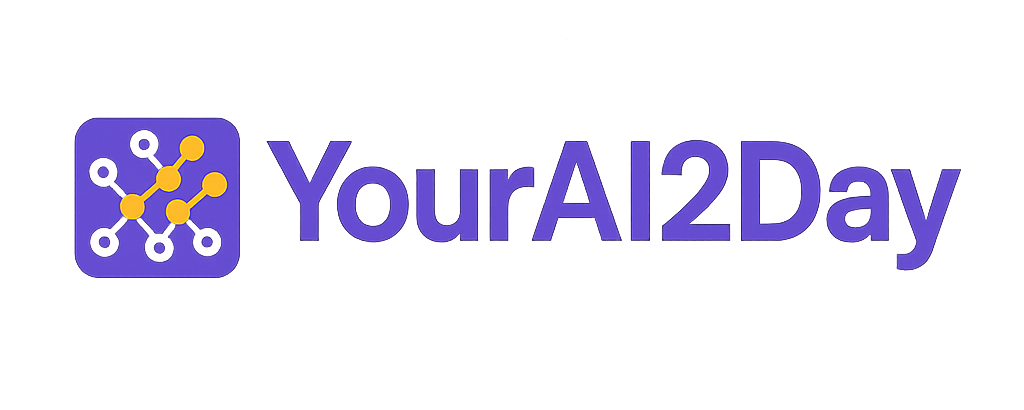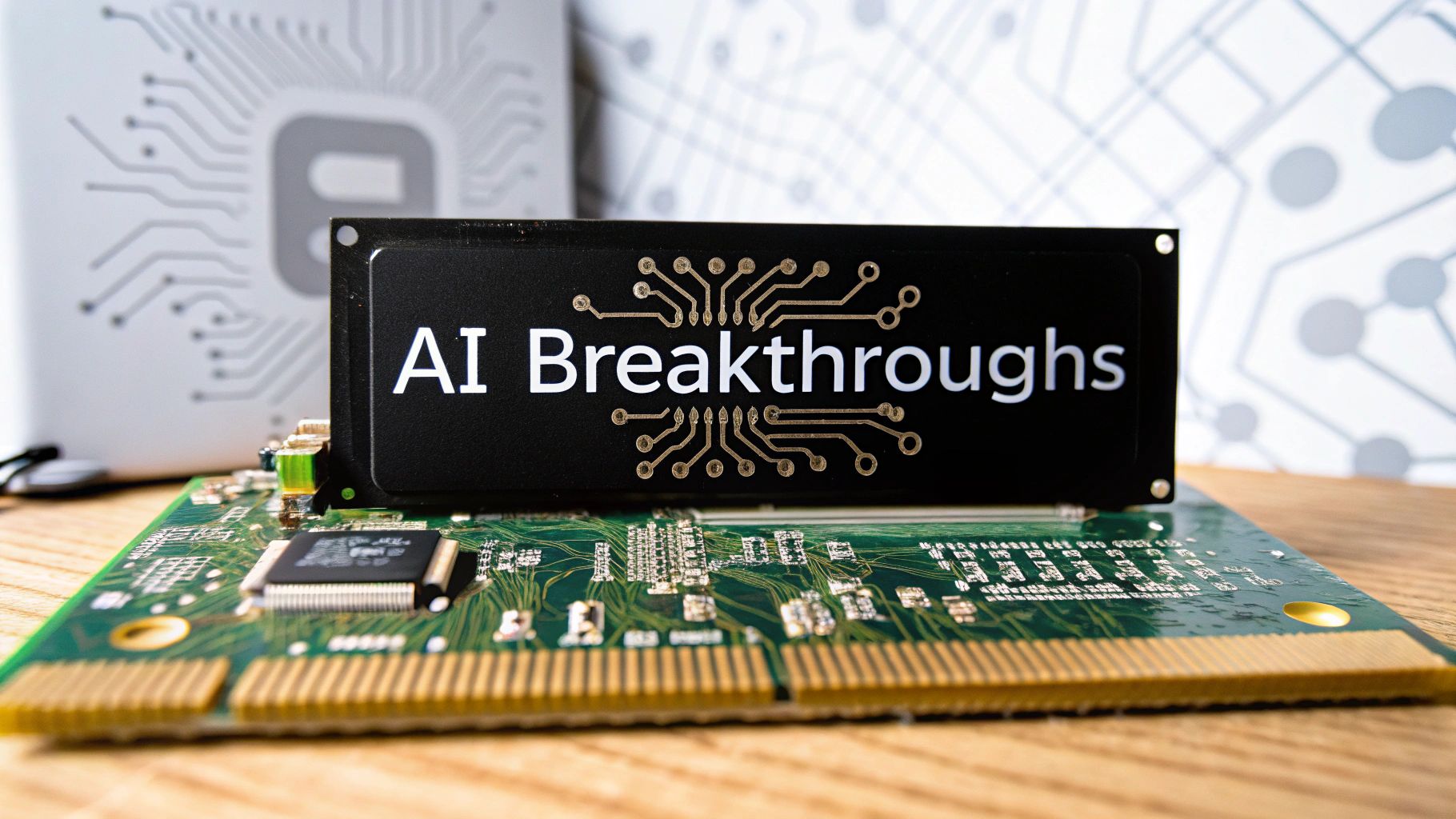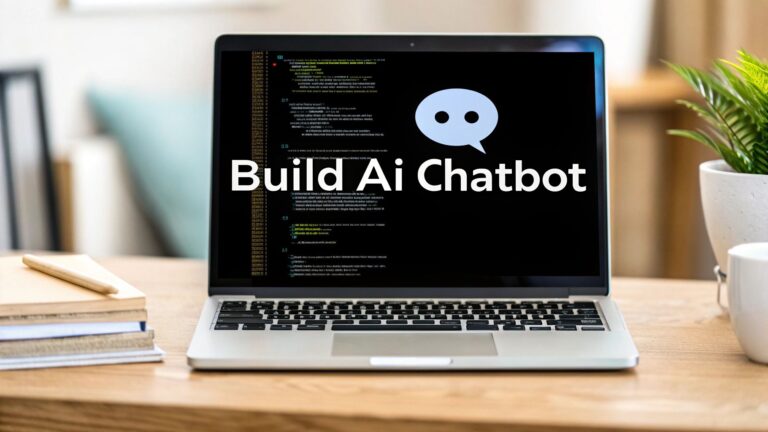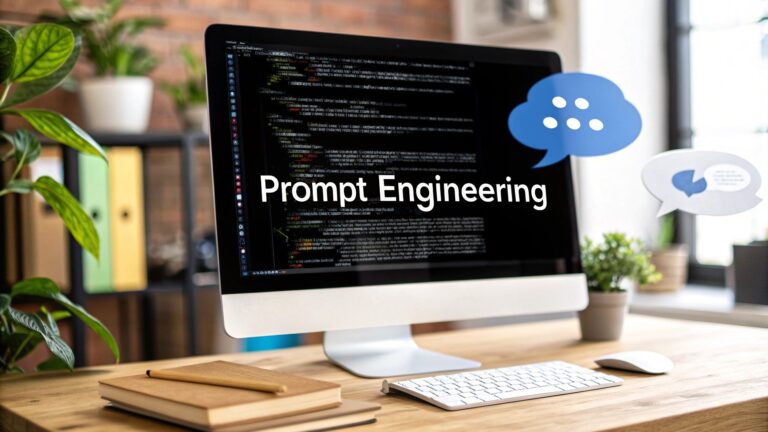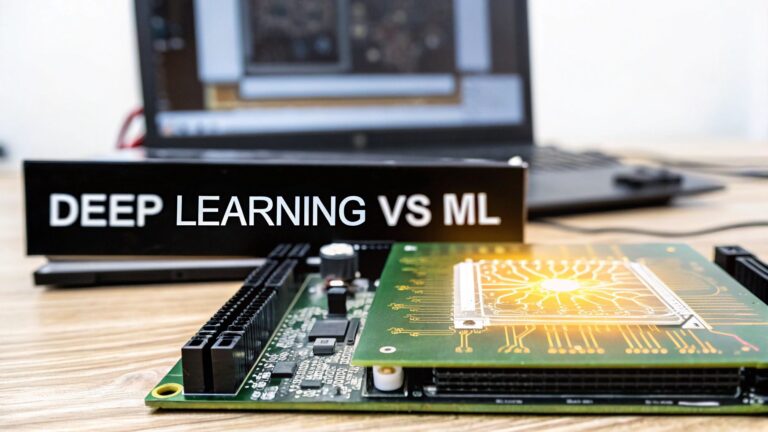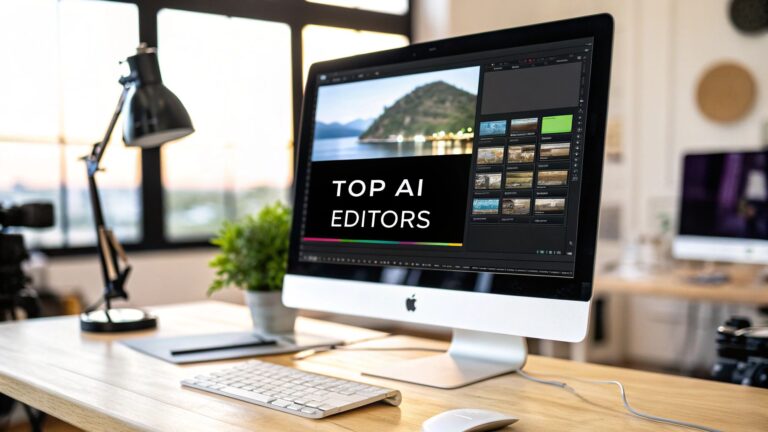artificial intelligence breakthroughs: 10 milestones that shaped our world
Ever wonder how your phone can recognize your face, or how ChatGPT can write a poem in seconds? It's not magic—it's artificial intelligence, and it's already a huge part of our daily lives. From the shows Netflix recommends to the way doctors can spot diseases earlier, AI is quietly working in the background. But how did we get here? What were the big "aha!" moments that took AI from a sci-fi dream to a real-world tool you can use today?
This article is your friendly guide to the most important artificial intelligence breakthroughs. We'll skip the confusing jargon and break down the ten key milestones that made modern AI possible. Think of it less like a dry history lesson and more like a backstage tour of the tech that powers your favorite apps.
For each breakthrough, we'll cover:
- What it is: A simple, conversational explanation of the core idea.
- Why it matters: How it changed the game and what it means for you.
- Practical examples: Where you can see this tech in action right now.
By the end, you'll not only understand what makes tools like ChatGPT and Midjourney tick, but you'll also see how these foundational ideas are paving the way for the next wave of amazing innovations. Let's dive into the breakthroughs that started it all.
1. Deep Learning and Neural Networks (2010s)
The 2010s were a huge turning point for AI, mostly thanks to deep learning. Imagine it like this: older AI was like a computer that needed a very specific checklist to identify a cat ("Does it have pointy ears? Whiskers? A long tail?"). It was slow and rigid. Deep learning, on the other hand, is like showing a computer thousands of cat photos and letting it figure out for itself what makes a cat a cat.
This technique uses "neural networks" with many layers (that's the "deep" part) that are loosely inspired by the human brain. Each layer learns to spot something different, from simple edges and colors to more complex shapes, until it can confidently say, "Yep, that's a cat." This ability to learn from raw data without being spoon-fed rules is what makes deep learning one of the most fundamental artificial intelligence breakthroughs.
Real-World Impact and Implementation
Deep learning is everywhere. When you use Google Photos to search for "beach," and it finds all your vacation pictures, that's deep learning. When Spotify creates a "Discover Weekly" playlist that feels like it read your mind, that's also deep learning. A huge moment was in 2012 when a system called AlexNet blew away the competition in an image recognition contest, proving this approach was the real deal.
Expert Opinion: As AI expert Andrew Ng puts it, "AI is the new electricity." He means that just like electricity transformed every industry a century ago, deep learning is doing the same thing today. It's a foundational technology that powers everything else.
Here’s how people are putting it to use:
- Practical Example: A small business owner can use an off-the-shelf deep learning tool to analyze customer reviews, automatically categorizing them as positive, negative, or urgent without having to read thousands of comments manually.
- For Beginners: You can play with Google's "Teachable Machine" online. It lets you train a simple model right in your browser to recognize images or sounds, giving you a fun, hands-on feel for how deep learning works.
To better understand the core differences and decide which approach is right for your project, you can learn more about the distinction between deep learning and traditional machine learning.
2. Transformer Architecture and Attention Mechanisms (2017)
In 2017, a research paper from Google called "Attention Is All You Need" completely changed how AI understands language. It introduced the Transformer architecture, which solved a huge problem: context. Before Transformers, AI models would read a sentence one word at a time, often forgetting the beginning of the sentence by the time they reached the end.
The Transformer's secret sauce is the self-attention mechanism. This allows the model to look at all the words in a sentence at once and figure out which ones are most important to each other. For example, in the sentence, "The cat chased the mouse because it was fast," attention helps the AI understand that "it" refers to the mouse, not the cat. This ability to see the whole picture made AI much better at understanding the nuances of human language and is easily one of the most critical artificial intelligence breakthroughs.
Real-World Impact and Implementation
The Transformer is the engine behind almost every modern language AI you've heard of, including ChatGPT, Google's Gemini, and Claude. It's what allows them to translate languages, write articles, and answer your questions so coherently.
Expert Opinion: Dr. Fei-Fei Li, a renowned AI researcher from Stanford, often speaks about moving AI from "pattern recognition to genuine understanding." The Transformer was a giant leap in that direction, giving models a much deeper grasp of context.
Here's how this tech shows up in your life:
- Practical Example: When you type a search query into Google, the Transformer architecture helps the search engine understand what you really mean, not just the keywords you typed. It gets the intent behind your words, which is why you get such relevant results.
- For Beginners: Every time you use a translation app like Google Translate and the result sounds natural and grammatically correct (instead of clunky and literal), you're seeing the Transformer in action.
To visualize how this powerful architecture works, this video offers a fantastic explanation.
3. Large Language Models (LLMs) – GPT Series (2018-Present)
Building on the power of Transformers, Large Language Models (LLMs) like OpenAI's GPT series (the tech behind ChatGPT) took things to a whole new level. Think of an LLM as a Transformer that went to the library and read the entire internet. They are trained on truly massive amounts of text and code, allowing them to develop a sophisticated understanding of language, facts, and reasoning.
What makes them so special is their versatility. You don't need to train them for one specific job. Instead, you can just ask them to do almost anything in plain English, a process called "prompting." Their ability to write an email, debug code, explain a complex topic, and then switch to writing a poem is what makes them one of the most user-friendly artificial intelligence breakthroughs. They made high-powered AI accessible to everyone, no programming required.
Real-World Impact and Implementation
LLMs are everywhere now. ChatGPT helps students with their homework, GitHub Copilot helps developers write code faster, and companies are using them to build smarter customer service bots. They've become a creative partner and a productivity tool for millions.
Expert Opinion: Sam Altman, CEO of OpenAI, has compared LLMs to a new kind of computer interface. Instead of clicking buttons, we can now just talk to the computer and tell it what we want. This natural language interface is fundamentally changing how we interact with technology.
Here are a few ways you can use them right now:
- Practical Example: A marketer who needs to create social media posts can ask an LLM, "Write five catchy tweets about our new eco-friendly water bottle. Use a fun and upbeat tone." In seconds, they get multiple options to work with, saving hours of brainstorming.
- For Beginners: Go to a free tool like ChatGPT or Google Gemini and try giving it a fun task. Ask it to "Explain quantum physics like I'm a five-year-old" or "Create a workout plan for a busy beginner." This is the best way to get a feel for what they can do.
To explore how these models are being applied in various industries, you can find more information about the diverse use cases of generative AI.
4. Convolutional Neural Networks (CNNs) for Computer Vision (2012)
If deep learning gave AI a brain, Convolutional Neural Networks (CNNs) gave it eyes. Back in 2012, CNNs made a huge splash by winning a major image recognition competition by a landslide. They are a special kind of neural network designed specifically for understanding images.
Here's a simple way to think about it: A CNN scans an image in small chunks, just like your eyes dart around to piece together a scene. It has different layers, and each layer looks for something specific. The first layers might spot simple things like edges, corners, and colors. The next layers combine those to find more complex patterns like eyes, noses, or wheels. Finally, the top layers put it all together to recognize a whole object, like a person's face or a car. This ability to see and understand the visual world made it one of the most important artificial intelligence breakthroughs.
Real-World Impact and Implementation
CNNs are the technology behind a lot of things you use every day. They power the face unlock feature on your smartphone, the system in a self-driving car that identifies pedestrians and stop signs, and even the app that can identify a plant from a photo you take.
Expert Opinion: Yann LeCun, a pioneer of CNNs and Chief AI Scientist at Meta, describes them as being inspired by the human visual cortex. He emphasizes that their hierarchical structure—learning simple features first and building up to complex ones—is key to their success.
Here's where you can see CNNs at work:
- Practical Example: On social media platforms like Facebook, CNNs are what automatically detect and suggest tagging your friends in photos. The AI recognizes their faces because it's been trained on millions of other images.
- For Beginners: If you've ever used a mobile banking app to deposit a check by taking a picture of it, you've used a CNN. The AI is trained to find the corners of the check, read the numbers, and process the deposit automatically.
5. Reinforcement Learning and Game Playing (AlphaGo, 2016)
In 2016, the world was stunned when Google DeepMind's AI, AlphaGo, beat the world's best player at the ancient game of Go. This was a huge deal because Go is incredibly complex and is said to require human intuition. The victory was a massive showcase for reinforcement learning (RL).
Unlike other types of AI that learn from data, RL works more like how you'd train a puppy. The AI agent (the "puppy") tries different actions in an environment (like a game). When it makes a good move, it gets a reward (a "treat"). When it makes a bad one, it gets a penalty. Over millions of trials, it learns a strategy to maximize its rewards. AlphaGo didn't just memorize human games; it played against itself millions of times, discovering brand-new, creative strategies that no human had ever thought of. This proved that AI could not only learn but also create, making it a truly profound artificial intelligence breakthrough.
Real-World Impact and Implementation
While it started with games, the principles of RL are now being used to solve real-world problems. It's helping to design more efficient cooling systems for data centers, control robotic arms in factories, and even discover new drug molecules.
Expert Opinion: Demis Hassabis, the co-founder of DeepMind, said that the goal with AlphaGo was "to build an AI that can solve any problem." Games were just the perfect training ground because they have clear rules and objectives. The real prize is applying that problem-solving ability to science and medicine.
How does this apply outside of games?
- Practical Example: A logistics company might use reinforcement learning to optimize its delivery routes. The AI could learn from real-time traffic and delivery data to figure out the most efficient routes for its drivers, saving time and fuel without needing a human to program all the rules.
- For Beginners: While you can't easily "use" RL yourself, you see its principles in things like the recommendation algorithms on YouTube or TikTok. The algorithm "learns" what you like based on what you watch (a reward signal), getting better over time at showing you content you'll enjoy.
To see how these concepts are being applied today, you can explore more about DeepMind's ongoing research.
6. Generative Adversarial Networks (GANs) (2014)
In 2014, a clever idea called Generative Adversarial Networks (GANs) gave AI a creative imagination. A GAN is made of two neural networks that compete against each other. Think of it like a game between an art forger and an art critic.
- The Generator (the forger) tries to create realistic images (e.g., a photo of a human face).
- The Discriminator (the critic) tries to tell the difference between the generator's fake images and real ones.
At first, the forger is terrible, and the critic easily spots the fakes. But over time, the forger gets better at making convincing fakes, and the critic gets better at spotting them. This "adversarial" competition forces both to become experts, until the generator can create images that are almost indistinguishable from reality. This leap from simply analyzing data to creating brand new, realistic data was a mind-blowing artificial intelligence breakthrough.
Real-World Impact and Implementation
GANs have been used for all sorts of creative and practical tasks. They've been used in fashion design to create new clothing styles, in video games to generate realistic textures, and even in medicine to create synthetic medical images for training other AIs. They are also the technology behind "deepfakes," which highlights the need for responsible use.
Expert Opinion: Ian Goodfellow, the inventor of GANs, described the moment he had the idea as a "eureka" moment during an argument with friends. He realized that this competitive framework could solve the long-standing problem of getting AI to generate crisp, realistic images.
Here’s where you might have encountered GANs:
- Practical Example: Have you ever used a photo editing app to "age" your face or see what you'd look like with a different hairstyle? Many of these filters use GANs to generate a new, realistic version of your photo based on the changes you want.
- For Beginners: The website "This Person Does Not Exist" generates a new, hyper-realistic (but completely fake) human face every time you refresh the page. It's a striking and simple demonstration of a GAN's power.
To explore a more modern approach that builds on these generative concepts, you can dive into how diffusion models are pushing creative boundaries.
7. Diffusion Models for Generative AI (2020-Present)
In the last few years, a new technique called diffusion models has taken the AI art world by storm. If GANs are like an art forger, diffusion models are like a sculptor who starts with a block of marble and slowly chips away until a statue emerges.
Here's how it works: The AI is first trained by taking a clear image and gradually adding "noise" (random static) until the original picture is completely gone. Then, it learns how to reverse the process—how to start with pure noise and carefully remove it, step-by-step, until a clear, brand-new image is formed. This methodical process turned out to be more stable and often produced higher-quality results than GANs, especially when guided by text prompts. This technology powers the amazing text-to-image tools that have become so popular, making it one of today's most visible artificial intelligence breakthroughs.
Real-World Impact and Implementation
Diffusion models are the magic behind incredible AI art generators like Midjourney, Stable Diffusion, and OpenAI's DALL-E 2. They allow anyone to type a creative idea—like "a photorealistic astronaut riding a horse on Mars"—and get a stunning, original image back in seconds. This has been a game-changer for artists, designers, and marketers.
Expert Opinion: Emad Mostaque, the founder of Stability AI (the company behind Stable Diffusion), believes that making these powerful generative tools open-source is key. He sees them as a way to unlock "the collective intelligence and creativity of humanity," allowing anyone to build upon them.
How you can use this technology:
- Practical Example: A small business creating a new website can use a diffusion model to generate unique, royalty-free images for its blog posts and marketing materials, instead of relying on generic stock photos.
- For Beginners: Try out a free tool like Microsoft Designer's Image Creator (which uses DALL-E). Experiment with different text prompts and see what kind of amazing images you can create. It's an incredibly fun and intuitive way to interact with cutting-edge AI.
8. Transfer Learning and Pre-trained Models (2010s-Present)
One of the most practical artificial intelligence breakthroughs isn't a flashy new model, but a clever, efficient idea: transfer learning. Imagine you spent years learning to play the piano. If you then decided to learn the organ, you wouldn't start from scratch. You'd transfer your knowledge of keys, scales, and music theory, making it much easier to learn the new instrument.
Transfer learning is the same idea for AI. Instead of training a new AI model from zero for every single task, which takes tons of data and computing power, developers can start with a "pre-trained" model that has already been trained on a massive general dataset. For example, a model trained on millions of internet images already knows how to recognize basic shapes, textures, and objects. You can then take that pre-trained model and fine-tune it on a much smaller, specific dataset (like pictures of different types of birds) to quickly make it an expert in that one area.
Real-World Impact and Implementation
Transfer learning has made AI accessible to far more people and companies. It means a small team without Google's resources can still build a powerful, custom AI application. It's the reason why so many niche AI tools have popped up recently.
Expert Opinion: Andrew Ng, a leading AI educator and founder of Coursera, has said that "transfer learning will be the next driver of ML commercial success after supervised learning." He sees it as a key to unlocking practical AI applications across all industries.
Here's how it makes AI more practical:
- Practical Example: A doctor's office wants to build an AI to spot signs of a specific disease in medical scans. Instead of collecting millions of scans (which would be impossible), they can take a pre-trained image recognition model and fine-tune it on just a few hundred of their own labeled scans to achieve high accuracy.
- For Beginners: If you've ever used an app that can identify a specific dog breed from a photo, it's almost certainly using transfer learning. It started with a general model that knows what animals look like and was then fine-tuned to become a specialist in dog breeds.
To see this in action, check out this fascinating story of how Gemini was taught to spot exploding stars with just a few examples.
9. Neural Architecture Search (NAS) and AutoML (2016-Present)
For a long time, designing a top-performing AI model was a bit of a dark art, requiring years of experience and a lot of trial and error from highly paid experts. Then came Neural Architecture Search (NAS) and AutoML (Automated Machine Learning), which basically use AI to design better AI.
Think of it like this: Instead of a human engineer trying to figure out the best way to connect all the layers in a neural network, a NAS algorithm explores thousands or even millions of different designs automatically. It tries out different combinations, tests how well they work, and uses that feedback to intelligently search for an optimal structure. This not only saves a huge amount of time but often results in AI models that are more accurate and efficient than anything a human could have designed.
Real-World Impact and Implementation
AutoML has been a huge step in making AI more accessible. Platforms like Google's AutoML allow people with little to no coding experience to upload their data and have the system automatically build a custom-trained model for them. This is powering a new wave of AI adoption in businesses of all sizes.
Expert Opinion: Jeff Dean, the head of Google AI, has talked about AutoML as a way to "amplify" human ML experts. By automating the tedious parts of model design, it frees up researchers to focus on more creative, high-level problems.
Here's how this automation helps:
- Practical Example: An e-commerce company wants to build a model to predict which customers are likely to stop buying from them. Using an AutoML platform, they can upload their customer purchase history, and the service will automatically test different models and deliver a high-performing one without the company needing to hire a team of data scientists.
- For Beginners: This technology is often behind the scenes, but it's what enables many easy-to-use AI services. When a tool promises to build a "custom AI for your business" with just a few clicks, it's likely using AutoML to do the heavy lifting.
10. Multimodal AI and Vision-Language Models (2021-Present)
One of the newest and most exciting frontiers in AI is multimodal AI. Humans experience the world using multiple senses at once—we see, hear, and read to understand what's going on. For a long time, AI models were specialists; one was good at images, another at text. Multimodal AI breaks down those walls, creating systems that can understand and connect information from different sources, like text, images, audio, and video, all at once.
A great example is a vision-language model. You can show it a picture and ask it a question in plain English. For example, you could show it a photo of your refrigerator's contents and ask, "What can I make for dinner with this?" The AI needs to see the ingredients and understand your question to give you a recipe. This ability to reason across different types of data is a major step towards more general and helpful AI, making it a very current artificial intelligence breakthrough.
Real-World Impact and Implementation
Multimodal AI is what powers the latest features in models like Google's Gemini and OpenAI's GPT-4. It's enabling new tools that feel much more intuitive. Think of apps that can describe a scene to a visually impaired person or search engines where you can use an image and text to find exactly what you're looking for.
Expert Opinion: Many researchers, including those at OpenAI, believe that multimodality is a key step toward achieving Artificial General Intelligence (AGI). By learning from the rich, interconnected data of our world, AI can develop a more robust and common-sense understanding.
Here’s how you can see this tech today:
- Practical Example: The Google Lens feature on your phone is a great example of multimodal AI. You can point your camera at a landmark, and it will recognize it and show you information about it. It's connecting what it sees (the image) with a database of knowledge (text) to give you a useful answer.
- For Beginners: Try the multimodal features in the latest version of the ChatGPT or Gemini apps. You can upload a photo of a math problem from a textbook and ask it to explain the solution step-by-step.
For a cool real-world application, see how foundation models and cross-modal reasoning are unlocking new geospatial insights.
Comparison of 10 Major AI Breakthroughs
| Item | Implementation Complexity 🔄 | Resource Requirements ⚡ | Expected Outcomes 📊⭐ | Ideal Use Cases 💡 | Key Advantages ⭐ |
|---|---|---|---|---|---|
| Deep Learning and Neural Networks (2010s) | Moderate → High (deep training pipelines, hyperparameter tuning) | High (large labeled datasets, GPUs/TPUs) | 📊 Strong accuracy on complex tasks; ⭐ scalable representations but limited interpretability | Broad supervised tasks: vision, speech, translation, medical AI | ⭐ Automatic feature learning; versatile and scalable |
| Transformer Architecture and Attention Mechanisms (2017) | High (self-attention, positional encodings, transformer stacks) | Very high (compute + memory; quadratic with sequence length) | 📊 SOTA for sequence modeling; ⭐ excellent long-range dependency capture | NLP, large-scale pretraining, sequence-to-sequence, vision transformers | ⭐ Parallel training, transferable contextual representations |
| Large Language Models (LLMs) – GPT Series (2018–Present) | Very high (massive pretraining, deployment engineering, safety layers) | Extreme (hundreds of billions–trillions of params; costly inference) | 📊 Very broad capabilities and few-/zero-shot learning; ⭐ versatile but prone to hallucinations | Conversational agents, code generation, creative writing, assistants | ⭐ Generalist performance across many tasks; emergent reasoning |
| Convolutional Neural Networks (CNNs) for Computer Vision (2012) | Moderate (well-understood conv/pooling architectures) | High (large image datasets; training compute) | 📊 Excellent image recognition and detection; ⭐ efficient spatial feature learning | Image classification, object detection, medical imaging, real-time perception | ⭐ Parameter efficiency (weight sharing) and strong pre-trained backbones |
| Reinforcement Learning and Game Playing (AlphaGo, 2016) | High (RL loops, MCTS, self-play orchestration) | Very high (massive self-play/simulation compute; environment complexity) | 📊 Superhuman performance in narrow strategic domains; ⭐ strong planning and long-term optimization | Strategy games, robotics control, complex optimization tasks | ⭐ Self-improvement via self-play and integrated planning/search |
| Generative Adversarial Networks (GANs) (2014) | High (adversarial training; instability management) | High (GPU training for high-res outputs) | 📊 Produces photorealistic samples; ⭐ high visual fidelity but training unstable | Image synthesis, image-to-image translation, data augmentation, creative media | ⭐ High-fidelity generation; flexible architectures for many domains |
| Diffusion Models for Generative AI (2020–Present) | Moderate → High (iterative denoising pipeline; sampling steps) | High (costly training; slower iterative sampling; latent methods reduce cost) | 📊 State-of-the-art image synthesis with better mode coverage; ⭐ stable training | Text-to-image, inpainting, high-quality generative content, audio generation | ⭐ Stable training and theoretical grounding; superior diversity vs GANs |
| Transfer Learning and Pre-trained Models (2010s–Present) | Low → Moderate (fine-tuning workflows, domain adaptation) | Low to Moderate (leverages pre-trained checkpoints; reduced data) | 📊 Faster development and strong performance on small datasets; ⭐ cost-effective | Domain-specific fine-tuning, small-data scenarios, rapid prototyping | ⭐ Reduces data/compute needs; democratizes access to powerful models |
| Neural Architecture Search (NAS) and AutoML (2016–Present) | High (automated search pipelines; complex optimization) | Very high (search can be compute-intensive; optimizations exist) | 📊 Can discover top-performing or hardware-tailored architectures; ⭐ reproducible automation | Hardware-aware model design, mobile/edge optimization, non-expert model building | ⭐ Automates architecture & hyperparameter design; finds efficient novel models |
| Multimodal AI and Vision-Language Models (2021–Present) | High (modality alignment, multi-encoder fusion, contrastive objectives) | High (aligned multimodal datasets; increased compute and latency) | 📊 Improved cross-modal understanding and robustness; ⭐ enables new multimodal tasks | Visual question answering, image captioning, multimodal assistants, search | ⭐ Unified cross-modal reasoning; improved zero-shot and transfer abilities |
What's Next? The Future is Being Built Today
We've just zipped through a decade of incredible innovation, from AI learning to "see" with CNNs to creating breathtaking art with Diffusion Models. Each of these artificial intelligence breakthroughs isn't just a cool science project; it's a building block that has led to the amazing tools we can all use today.
The big story here is how these ideas connect and build on each other. The Transformer architecture was the key that unlocked the power of LLMs. Transfer learning lets us take those giant models and apply them to solve our own unique problems. And now, Multimodal AI is bringing all these senses together, creating a much smarter and more helpful kind of AI.
The Key Takeaway: A Symphony of Progress
If there’s one thing to take away, it's that AI progress is happening fast because these breakthroughs feed into each other. Understanding them gives you a map to where things are headed.
- Generative AI is your new creative partner: Tools that can write, code, and create images are now at your fingertips. This is a massive opportunity for anyone who makes things—whether you're an artist, a marketer, or an entrepreneur.
- Efficiency is the next big thing: Today's models are powerful but huge. The next challenge is to make them smaller, faster, and more accessible so they can run on your phone, not just in a giant data center.
- Integration is everything: The coolest tools of the future will combine these technologies. Imagine an AI that can watch a video, listen to the audio, and give you a summarized, text-based report. That's where we're going.
Your Actionable Next Steps on the AI Journey
Reading about this stuff is great, but the best way to understand it is to use it. As the old saying goes, the best way to predict the future is to build it.
Here’s how you can get started today:
- Experiment Hands-On: Don't be shy! Go play with ChatGPT, Gemini, or Claude. Ask them to help you with a real task—brainstorm ideas for a blog post, write a tricky email, or explain a concept you're curious about. Use an image generator like Midjourney or Stable Diffusion to bring a silly idea to life. This is how you build real intuition.
- Identify a Problem You Can Solve: Think about your work or hobbies. Is there a repetitive, boring task you could automate? Could you use AI to generate first drafts for your marketing content? Applying these tools to a real problem you have makes their value click instantly.
- Follow the People Building the Future: The researchers and developers at places like OpenAI, Google DeepMind, and Meta AI often share what they're working on. Following them on social media or reading their blogs is like getting a sneak peek into the future.
Artificial intelligence is no longer some far-off concept. It's here, it's useful, and it's more accessible than ever. The breakthroughs of the last ten years have set the stage for an even more exciting decade to come. Now that you know the key milestones, you're in a great position to understand, use, and even help build what comes next.
Ready to move from learning to doing? Keeping up with the constant stream of artificial intelligence breakthroughs can be overwhelming, but YourAI2Day makes it easy. We curate the latest news, tools, and tutorials to help you stay ahead of the curve and apply AI in practical ways. Visit YourAI2Day to join our community and turn today’s breakthroughs into your tomorrow’s success.
